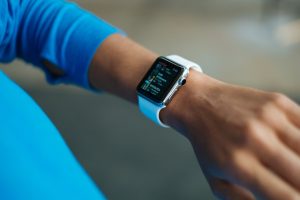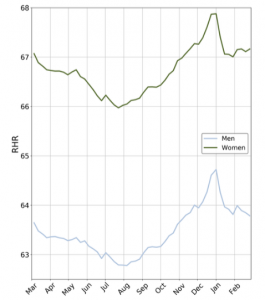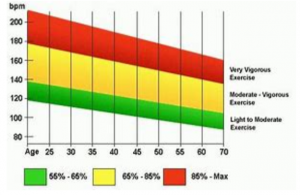
21 Feb Movement Matters: The Beat Goes On…but what does it mean?
We are fascinated with our heart rate. We have watches and wearables and an array of gadgets to capture and display our heart rates. We have colorized our heart rate zones for the purpose of rewarding ourselves with points as we exercise. Yet while more people than ever are measuring this basic health parameter, we struggle to understand how to use it to improve our health. 
It is easy to confuse data for truth. Here are some facts to help us put this heart rate thing into a context that allows us to harness its power to improve our fitness, and to track those improvements over time.
- Resting heart rate (RHR) averages 64-68 beats per minute for women, and 60-65 for men. RHR is highly variable between individuals, so much so that researchers have asserted that RHR is better used in assessing changes over time than as a single isolated measure.
- RHR in general varies over the course of a year in the same individual, being lowest in the late summer and highest at the end of the year. (see chart below)
- RHR in general is lower in individuals who are more fit, and over time will decrease in response to a steady dose of exercise, reflecting a more efficient heart.
- RHR in general increases slightly to middle age, and decreases slightly with age after 50.
- RHR in general is increased in individuals with greater body mass (BMI)
- RHR is in general increased in individuals averaging less than 7 hours of sleep, and is increased again in those averaging greater than 8 hours of sleep.
Weekly variation in overall average RHR for women (dark line) and men (light line) over 1 year. https://doi.org/10.1371/jounal pone.0227709, published February 5, 2020.
Tracking our heart-rate response to exercise is an important aspect of structuring our workouts and ensuring that we are working hard enough, or steadily enough, to achieve the desired effect. In general, exercising at 70-95% of our maximum heart rate provides significant health benefits, aiding in weight control, cardiovascular fitness, and enhancing performance.
- The simplest way to calculate our theoretical Max HR is to subtract our age from 220. According to this method, a 50 year old would have a Max HR of 170.
- Exercising at a high intensity (over 85% of your Max HR) stresses the heart to become more efficient and stronger. This type of exercise is utilized in high intensity interval training (HIIT), using carbohydrates for fuel to improve cardiovascular health in relatively short bouts of exercise.
- Lower intensity exercise (65-80% of your Max HR) provides a slower burn and provides great benefit in longer bouts of exercise. This type of exercise preferentially burns fat for fuel.
- The American Heart Association recommends that we get at least 150 minutes per week of moderate-intensity exercise (65-80% of Max HR) or 75% of high intensity exercise (>85% Max HR), or a combination of both.
- In general, as you become more fit your Heart Rate response to exercise will decrease, requiring you to work harder to reach higher percentages of your Max HR.
- Individuals who are more fit require a larger dose of both low and high intensity exercise to maintain and improve cardiovascular health.
Finally, don’t let your device do all of the thinking for you. Early this winter I was struggling to increase my fitness and I wasn’t getting the affirmation from my watch that I had hoped for. I consulted friends. I consulted Google. I even went so far as to consult the user’s manual. As it turns out, the problem was twofold. First, the heart rate ‘zones’ on the device had not been re-calibrated to my age as noted above, so I was being underappreciated by my watch. Second and most importantly, I simply wasn’t working out hard enough! Lesson learned, you need to equate the effort of your workout with the electronic output!
And, as you well know, working on cardiovascular fitness can be impaired by pain or limited function of your musculoskeletal system. If you are in need of a tune-up to get on with the hard work of improving your heart health, contact one of our convenient locations where teams of empathetic, eager, and knowledgeable physical therapists are just waiting to push you toward your goals.
Best,
Brian






